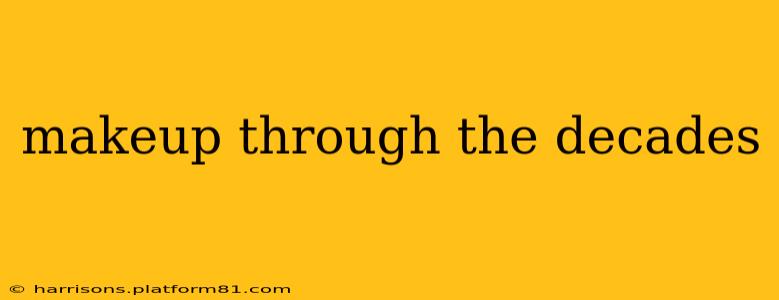Makeup trends have evolved dramatically throughout history, reflecting societal shifts, technological advancements, and changing ideals of beauty. From the subtle elegance of the 1920s to the bold experimentation of the 1980s and beyond, each decade has left its unique mark on the world of cosmetics. This journey through time explores the iconic makeup looks that defined each era, revealing the fascinating interplay between fashion, culture, and the artistry of makeup.
The Roaring Twenties: A Flapper's Delight
The 1920s, an era of liberation and jazz, saw a move away from the heavily powdered faces of the Victorian era. The focus shifted to a more natural, youthful look, though still meticulously crafted. Think pale skin, defined eyebrows, a touch of rouge on the cheeks, and a bold, dark lip. The iconic "flapper" look emphasized a youthful, androgynous aesthetic, with a focus on the eyes rather than a heavily contoured face. This era saw the rise of mascara and eyebrow pencils, empowering women to enhance their natural features.
What were the key makeup trends of the 1920s?
The key makeup trends of the 1920s included a pale complexion achieved with powder, dark, defined eyebrows, a subtle blush, and a deep, often dark red or berry-colored lipstick. The focus was on a clean, almost boyish look, a stark contrast to previous decades.
The Hollywood Glamour of the 1930s and 1940s
The Great Depression and World War II influenced the makeup trends of the subsequent decades. The 1930s saw a continuation of the pale face, but with a greater emphasis on defined eyes and eyebrows. Think Marlene Dietrich—strong brows, dramatic eyes, and a perfectly sculpted cupid's bow. The 1940s brought a more matte finish, with a focus on creating a sculpted, "pin-up" look. Red lipstick became a symbol of wartime resilience and femininity, while a strong, defined eyebrow continued to be a key element.
How did wartime affect makeup trends?
World War II led to rationing, impacting the availability of certain cosmetic ingredients. However, makeup remained important as a symbol of morale and femininity. The focus shifted towards more practical, long-lasting products, and a slightly more muted palette compared to the pre-war era.
The 1950s: A Return to Soft Romance
The post-war era ushered in a softer, more romantic look. Think Audrey Hepburn and Grace Kelly—delicate features, rosy cheeks, and a focus on creating a naturally flawless complexion. Eyeliner became more prominent, with a cat-eye look emerging as a popular choice. Lipstick shades moved towards softer pinks and corals, complementing the overall air of understated elegance.
What were the most popular lipstick shades in the 1950s?
Soft pinks, corals, and rose tones dominated the 1950s lipstick palette, reflecting the era's emphasis on a softer, more romantic image.
The 1960s: Mod and Youthful Rebellion
The 1960s brought a bold shift towards a more youthful, experimental aesthetic. The "mod" look, characterized by Twiggy's signature pale face, thick, dark eyeliner, and false lashes, epitomized this rebellious spirit. Pastel eyeshadows and a focus on clean, defined features became increasingly popular, reflecting the era's embrace of youthful energy and self-expression.
How did the 1960s makeup differ from previous decades?
The 1960s saw a rebellion against the softer, more romantic looks of the 1950s. The emphasis shifted to youthful experimentation, with bold eyeliner, false eyelashes, and a focus on creating a clean, almost androgynous look.
The Disco Fever of the 1970s
The 1970s embraced bold color and shimmer. Disco fever fueled a trend towards dramatic eyeshadow, often in metallic shades like bronze and gold. Blush became a key feature, creating a healthy, glowing complexion. The focus was on creating a glamorous, high-impact look, reflecting the era's exuberant energy.
What were the dominant eyeshadow colors of the 1970s?
Metallic shades, particularly bronze and gold, were dominant in the 1970s, reflecting the decade's embrace of glamour and disco culture.
The 1980s: Power Dressing and Bold Statements
The 1980s were all about bold statements. Think bright eyeshadow, often in clashing colors, dramatic blush, and heavily contoured features. This era saw a rise in the use of bronzer and highlighter, creating a sculpted, almost exaggerated look. The focus was on creating a powerful, confident image, reflecting the changing role of women in society.
What made 1980s makeup so distinctive?
The 1980s makeup was defined by its boldness. Bright, often clashing eyeshadows, heavy contouring, and dramatic blush created a powerful and highly visible aesthetic.
The 1990s: Grunge and the "No Makeup" Makeup Look
The 1990s brought a reaction against the excess of the 1980s. The grunge movement influenced a more understated, natural look, often referred to as the "no makeup" makeup look. A focus on a flawless complexion, minimal eyeshadow, and a neutral lip became increasingly popular. However, this era also saw a rise in the use of lip gloss and brown lipstick.
How did the 1990s makeup trends differ from the 1980s?
The 1990s saw a move away from the bold, dramatic makeup of the 1980s towards a more natural, understated look. The "no makeup" makeup look emphasized a flawless complexion and minimal use of color.
The 21st Century and Beyond: A Constant Evolution
The 21st century has witnessed a constant evolution of makeup trends, with social media playing a significant role in shaping and disseminating the latest looks. From the rise of contouring and highlighting to the embrace of diverse skin tones and makeup styles, the modern era celebrates individuality and experimentation. The focus has shifted towards inclusivity, self-expression, and a celebration of personal beauty.
This retrospective offers a glimpse into the fascinating evolution of makeup through the decades. Each era reflects the societal values, cultural influences, and technological advancements of its time, underscoring the powerful role of cosmetics in shaping individual identity and collective aesthetics.
